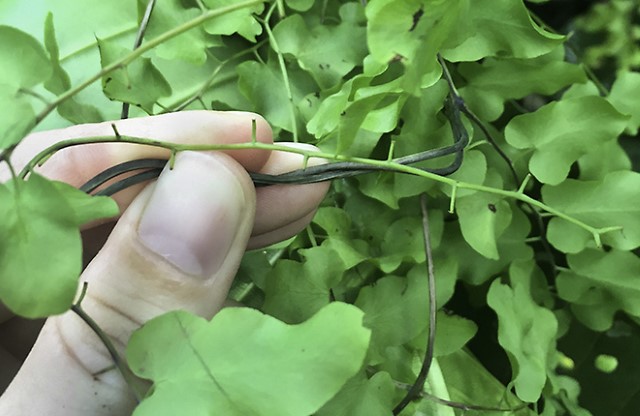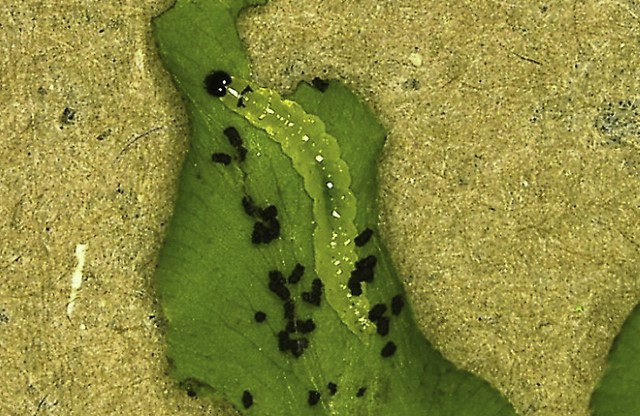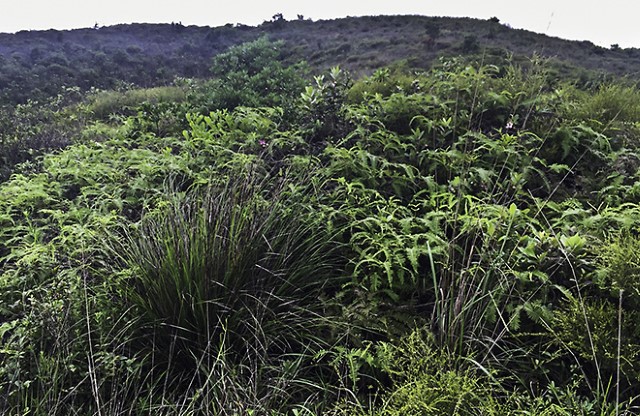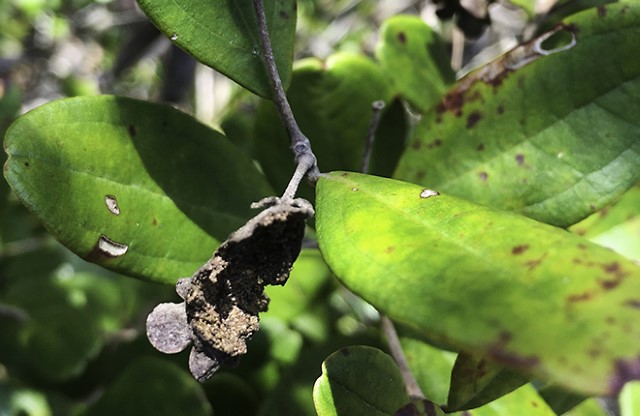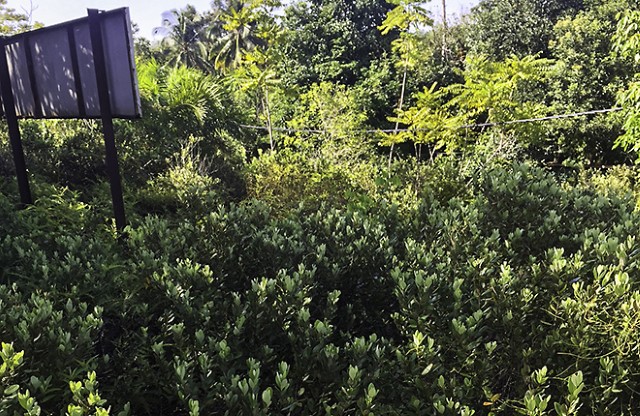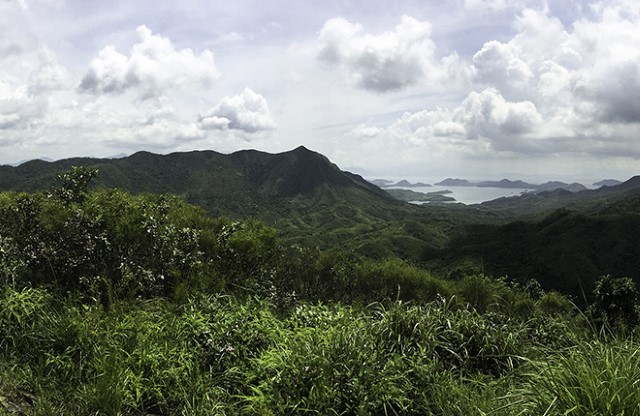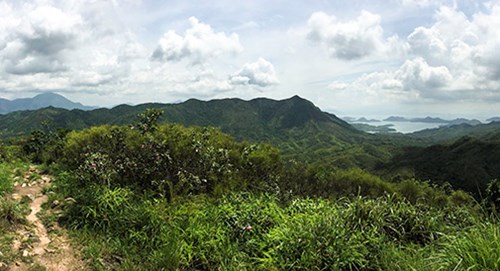Looking for Biocontrol in Asia for Invasive Plants
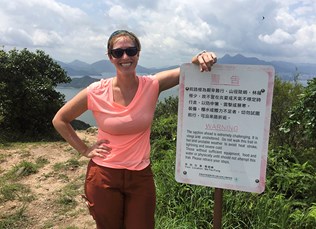 ARS ecologist Melissa Smith with sign warning of a dangerous trail up ahead at the Plover Cove Country Park in Hong Kong. (Jeffrey Makinson, CSIRO, D3691-1) |
Predator and prey co-evolve as part of a natural “arms race” for survival. When plants and animals are moved from their native habitats to new locales where they have no natural enemies, their populations can increase if left unchecked. Paper bark tree (Melaleuca quinquenervia), Old World climbing fern (Lygodium microphyllum), and downy rose myrtle (Rhodomyrtus tomentosa) are all native to Asia and highly invasive in Florida and Hawaii. And though downy rose myrtle has beautiful flowers and edible fruit, it invades native pinelands in Florida, forming dense thickets that displace native flora and fauna. Agricultural Research Service (ARS) ecologist Melissa Smith recently went on a collection trip to Asia to find insects to stop the spread of these invasive plants. Here are some highlights from her research diary that chronicle her scientific expedition:
Traveler: Melissa C. Smith, Ecologist
Duty Station: Invasive Plant Research Laboratory, Fort Lauderdale, Florida
Purpose: Biological Control of melaleuca (Melaleuca quinquenervia), Old World climbing fern (Lygodium microphyllum), and downy rose myrtle (Rhodomyrtus tomentosa)
Trip dates: June 3-20, 2016
Singapore
 Australian researcher Matt Purcell collecting hydrilla in China. (Jailiang Zhang, CAS, D3692-1) |
Matt Purcell—a collaborating entomologist and leader of the Australian Biocontrol Laboratory in Brisbane—and I set out to look for Old World climbing fern and downy rose myrtle sites in parks and along roadsides. We found several small stands of Old World climbing fern alongside other Lygodium species. Unfortunately, little appeared to be grazing on the leaves or stems. We eventually found two individual moths of the foliage feeder Lygomusotima stria and another individual of Callopistria, a foliage feeding species that has yet to be identified, feeding on Old World climbing fern. We also found the case-bearing beetle Cryptocephalus trisfasciatus on downy rose myrtle, though this species has already been tested and found to feed too broadly for biological control uses.
Later, Matt and I explored the mountain area around Dairy Farmers Road and Bukeh Timah Park on the north end of the island in search of insects on Lygodium microphyllum. Though several small patches of Old World climbing fern showed signs of feeding, we did not find the insect herbivores for which we were looking. Upon exiting the trail, we came upon patches of Lygomusotima stria moths feeding on L. microphyllum and made a record of their location. Because this was a fact-finding trip to Singapore, Matt will return in a couple of weeks to gather the emerging larvae after obtaining official collection permits.
We continued our exploration the next day at Sungei Buloh Wetland Reserve on the northwest side of the island overlooking Malaysia, but we did not find Old World climbing fern there. On the way back to the hotel, we found downy rose myrtle in decorative plantings in the parking lot. This was the fourth time we had seen the plant used in landscaping around public buildings and roads. Downy rose myrtle is native to Malaysia and probably Singapore, but was eradicated due to development. The extensive use of the plant in landscaping may attract peninsular-Malaysian herbivores into Singapore, thereby making them easier to collect.
Singapore continues to be an excellent source of material, especially for Old World climbing fern, due to its proximity to both mainland Asia and the South Pacific islands. Additionally, the Singapore Ministry of Agriculture has a long working relationship with the Australian Biocontrol Laboratory and ARS and regularly and efficiently grants export permits for plants and insects.
Malaysia
After 5 days in Singapore with only a few sites on which to follow up, we departed for our surveys of Malaysia. We flew into Kuala Lumpur and immediately departed for Pekan, where we came across downy rose myrtle and the occasional Old World climbing fern and melaleuca tree en route. The downy rose myrtle we inspected was remarkably healthy with good fruit set and almost entirely untouched leaves. We observed large-scale outbreaks of myrtle rust, a generalist myrtle pathogen, on the plants in Singapore. Myrtle rust is also prevalent here in Malaysia, though not to the same degree, probably because of lower humidity.
We spent the next 2 days traveling the inland coastal road north to Kota Bharu, where we found many roadside stands of downy rose myrtle, most of which were heavily infested with Idiophantis spp. moths that appeared to be affecting fruit development. The leaves did not show many signs of foliar herbivory. We observed one population affected by an unknown fungal pathogen and took pictures to show a pathologist in Australia. The moth Idiophantis has not yet been identified to species, nor has it been tested for its potential host range. The goal of subsequent trips to Malaysia will be to collect and rear populations for both host-range testing and identification.
We also observed frequent populations of Old World climbing fern but didn’t have time to inspect them thoroughly. Malaysia may be another source of biological control insects for Lygodium. We are currently pursuing an export permit with Malaysia, so all findings from this trip will be used for future collections. While these fact-finding trips do not yield immediate tangible collections, they’re invaluable for subsequent efforts because they resolve most of the logistical issues and locate many of the populations.
Hong Kong
|
|
Last on our collection journey was Hong Kong, which has been extensively explored for agents and plants before this trip. We surveyed many of the outlying areas including Lan Tau, Pak Lam, Lemma Island, and Shek O. Downy rose myrtle inhabits the higher elevation areas and dominates the secondary growth on hillsides. In the higher elevation areas, we collected downy rose myrtle stems with galls caused by Casmara spp. moths and shipped them immediately to entomologist and laboratory manager Susan Wright at ARS’s Invasive Plant Research Laboratory (IPRL) Gainesville quarantine facility. Shipping stem-boring insects as quickly as possible results in better survival. We also collected several dozen dried downy rose myrtle fruits that exhibited signs of Mesophleps moths feeding and also sent those to IPRL in Gainesville. We spent the next several days looking for the stem-boring moth Siamusotima aranea on Old World climbing fern. The moth is currently in quarantine at the IPRL quarantine facility in Fort Lauderdale and is one that we’ve tried multiple times to colonize but with little success. The species has great potential because the feeding behavior of the larva causes the entire stem of the fern to die. We collected 157 infested stems of Old World climbing fern and shipped or hand-carried them back to IPRL. One live larva of Callopistria spp. was also shipped to IPRL Fort Lauderdale to augment an existing colony that now supports host-range testing for this defoliating species. The samples were securely enclosed and delivered to quarantine upon arrival back in the United States.
More surveys need to be conducted in the downy rose myrtle native range, particularly with the absence of information regarding the origin of the species and the origin of Florida populations. We plan to pursue collections in Malaysia, focusing on the Idiophantis moth, and explore new sites in the Philippines and Indonesia.
Summary
Invasive species continue to be one of the leading causes of environmental harm, including threats to biodiversity, decreased agricultural yields, and impacts to human health. Effective long-term means of controlling these species is part of the USDA’s core mission, and biological control represents the most cost-effective and sustainable method of accomplishing this. Foreign surveys are the first step in an important effort to provide new biological control agents for large-scale plant invasions.—By Melissa C. Smith, ARS Invasive Plant Research Laboratory and Sharon Durham, ARS Office of Communications.
“Looking for Biocontrol in Asia for Invasive Plants" was published in the November 2016 issue of AgResearch Magazine.
Key Facts
- ARS ecologist Melissa Smith brought back insects from Asia for potential biocontrol of U.S. invasive plants.
- Invasive plants cost millions in damage nationwide per year.
- Biocontrol means less pesticide used and less adverse impact on the environment.
Full Story








